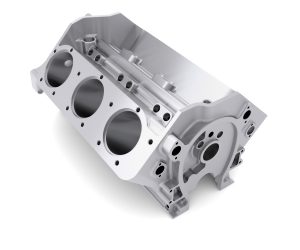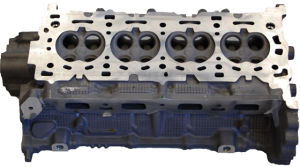
Years of research on technologies to optimize the production of lightweight car engines and other auto parts may soon pay off with big dividends for our automotive partners.
Source: Canadian Neutron Beam Centre (CNBC)
Contact: cnbc@cnl.ca
Image: Ford
Neutron beams, like no other tool, can be used to non-destructively probe deep inside engine blocks. This technique allows auto manufacturers to determine the amount of stress in the material at any given point, which is a key factor in the reliability of an engine.
Nemak Canada’s technologies, which are being developed with the CNBC, will speed production and reduce energy usage, saving millions in manufacturing costs.
Neutrons help Nemak Canada to speed engine manufacturing.
According to Nemak Canada, the technologies being developed in partnership with the Canadian Neutron Beam Centre (CNBC) — technologies that are now close to being implemented — will speed production times and reduce energy usage, thereby saving millions in manufacturing costs.

A V-6 aluminum engine block
In one line of research with Nemak, the objective was to find the best way to build robust V-6 aluminum engine blocks. These engines have extremely low tolerance for distortion in the shape of the cylinder holes in the block. Stress relief methods are used after casting the block to increase stability, and yet each manufacturing step comes with its own costs and impacts on the materials properties. To improve upon current manufacturing practices, the team needed to understand more clearly the factors contributing to stability.
Nemak and its research partners from Ryerson University accessed the CNBC’s neutron beams for several studies to acquire and interpret the neutron diffraction data. These studies included elucidating the stress distribution and microstructure in new aluminum alloys and in engine blocks, namely by examining the materials before, during and after stress relief methods such as heat treatment. Additionally, they included pioneering observations of microstructural evolution during solidification of the alloys.
The results were vital contributions to the success of the research, helping Nemak to determine that simplifying the heat treatment process is feasible without compromising reliability. Nemak is now moving forward to validate the new process by performing final tests, such as putting a prototype engine block in a test vehicle, in advance of the engine being used in vehicles sold to customers.
DOI:10.1016/j.matlet.2015.05.094
Neutrons help General Motors to accelerate engine development.
The CNBC’s measurements clearly falsified a hypothesis for GM concerning which of two manufacturing methods would be more effective in reducing residual stress in cylinder heads.
General Motors (GM) uses neutron beams to accelerate the development of engine heads and blocks. These projects span three primary research areas: (1) evaluating the effectiveness of heat treatment and quenching methods; (2) directly observing phase precipitation during solidification; and (3) creep testing to make better predictions of reliability over the long term.

A GM cylinder head
In the first area of evaluating the effectiveness of heat treatment and quenching methods, the CNBC’s measurements clearly falsified a hypothesis for GM—specifically, that the air quenching of cylinder heads would provide a benefit over water quenching because of an overall reduction in residual stresses. The results showed that, with air quenching, significant stresses remained deep inside the cylinder heads, at a depth of about one centimetre.
In the second research area of directly observing phase precipitation during solidification, GM uses modelling software to try to predict the properties of the components or alloys after they solidify, although sometimes these models fail to predict the actual results. Neutrons, however, can uniquely identify phases that precipitate during solidification. In other words, they allow GM to watch the solidification process experimentally to better understand what is causing the discrepancies.
The third research area is concerned with creep testing, which in essence means determining how the shape of a part may change over time and eventually fail or cause problems. The neutron beam experiments allow GM to look at how the arrangement of the atoms changes in the material to better understand how these changes take place.
DOI:10.1002/9781118888438.ch60
Neutrons help the Ford Motor Company to investigate riveting techniques for lightweight vehicles.

Cross-sectional image of a self-piercing rivet joining sheets of steel and alumninum
The CNBC has an ongoing research project with the Ford Motor Company to examine new ways of joining dissimilar materials for use in lightweight vehicles. For example, self-piercing riveting (SPR) is a leading alternative to traditional welding methods and has been widely used by Audi, Mercedes, BMW and Jaguar on their aluminum cars and SUVs. SPR joints have excellent mechanical properties and high fatigue resistance. Prior to the CNBC’s involvement, however, the 3D residual stress field in a mixed metal SPR joint had never been experimentally studied, making predictions for the fatigue life of such SPR joints difficult. Thus, Ford turned to the CNBC’s neutron beam capability because other ways of determining stresses were too difficult due to the complex geometry and number of different materials involved. Ford plans to use the results from the neutron analysis to validate its existing residual stress prediction method and to document these findings to inform broader manufacturing processes.

Illustration of applying a self-piercing rivet to join two materials
